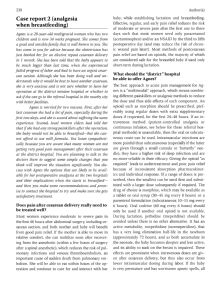Page 250 Guide to Pain Management in Low-Resource Settings
P. 250
238 Author(s)
Case report 2 (analgesia baby, while establishing lactation and breastfeeding.
when breastfeeding) Eff ective, regular, and early pain relief reduces the risk
of moderate or severe pain after the fi rst one to three
Agnes is a 28-year-old multigravid woman who has two days such that most women need only paracetamol
children and is now 34 weeks pregnant. She comes from (acetaminophen) and/or an NSAID by the third to fi fth
a good and sensible family that is well known to you. She postoperative day (and may reduce the risk of chron-
has come to you for advice because the obstetrician has ic wound pain later!). Most methods of postcesarean
just booked her for an elective repeat cesarean delivery pain relief are based on opioids, the majority of which
in 1 month. She has been told that the baby appears to are considered safe for the breastfed baby if used only
be much bigger than last time, when she experienced short-term during lactation.
failed progress of labor and had to have an urgent cesar-
What should the “district” hospital
ean section. Although she has been doing well and un-
be able to off er Agnes?
derstands why it would be best to have another cesarean,
she is very anxious and is not sure whether to have her Th e best approach to acute pain management for Ag-
operation at the district mission hospital or whether to nes is a “multimodal” approach, which means combin-
ask if she can go to the referral hospital in the nearby city ing diff erent painkillers or analgesic methods to reduce
with better facilities. the dose and thus side eff ects of each component. An
Agnes is worried for two reasons. First, after her opioid such as morphine should be prescribed, pref-
last cesarean she had a lot of pain, especially during the erably using regular doses with extra supplementary
fi rst two days, and she is scared about suff ering the same doses if requested, for the fi rst 24–48 hours. If an in-
experience. Second, local women elders had told her travenous method (patient-controlled analgesia or
that if she had any strong painkillers after the operation, continuous infusion, see below for these referral hos-
the baby would not be able to breastfeed—but she can- pital methods) is unavailable, then the oral or subcuta-
not aff ord to use milk formula. You listen sympatheti- neous route can be used. Intramuscular injections are
cally because you are aware that many women are not more painful than subcutaneous (especially if the latter
getting very good pain management after their cesarean are given through a small cannula or ‘butterfl y” nee-
at the district hospital. You are planning to talk to the dle); they have a higher risk of deep infection and are
doctors there to suggest some simple changes that you no more reliable in their effi cacy. Giving the opioid “as
think will improve the situation signifi cantly. You dis- required” leads to undertreatment and poor pain relief
cuss with Agnes the options that are likely to be avail- because of inconsistent absorption pharmacokinet-
able for her postoperative analgesia at the two hospitals ics and individual response. If a range of doses is pre-
and their implications when she starts to breastfeed— scribed, then the smallest can be used fi rst and substi-
and then you make some recommendations and prom- tuted with a larger dose subsequently if required. Th e
ise to contact the hospital to try and make sure she gets drug of choice is morphine, which may be available as
satisfactory treatment. a tablet or oral syrup (30–45 mg every 8 hours) or a
parenteral formulation (subcutaneous 10–15 mg every
Does pain after cesarean delivery really need to 6 hours). Oral codeine (60 mg every 6 hours) should
be treated well? only be used if another oral opioid is not available.
Most women experience moderate to severe pain in During lactation, pethidine (meperidine) should be
the fi rst 48 hours after abdominal surgery, including ce- avoided unless there is no other alternative. It has an
sarean section, and both mother and baby will benefi t active metabolite, norpethidine (normeperidine), that
from good pain relief. If the mother is able to move in has a very long elimination half-life in the newborn
relative comfort, she can mobilize soon after recover- (approximately 72 hours), and as both accumulate in
ing from the anesthetic (within a few hours of surgery the neonate, the baby becomes sleepier and less active,
after a spinal anesthetic), which reduces the risk of pul- and its ability to suck on the breast is impaired. Th ese
monary infections and venous thromboembolism, an eff ects are prominent when intravenous doses are giv-
important cause of sudden death from pulmonary em- en after cesarean delivery, but they also occur from
bolism. She will be able to eat within hours of the op- lower intramuscular dosing during labor. If the baby
eration and continue to care for and interact with her is very premature and has worrisome apneic spells, all


